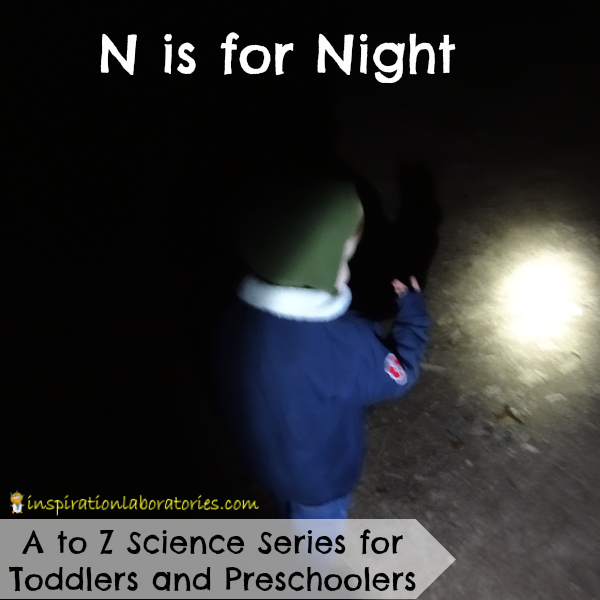N is for Night Exploration
The A to Z Science series for toddlers and preschoolers at Inspiration Laboratories continues with the letter N. N is for Night Exploration.
Night Time Science
The world outside is completely different at night. Take your children outside at night and let them explore. You can stay in the safety of your backyard and make observations there. Or you can go on a night hike at your favorite trail. Here are some ideas for exploration.
Listen
Depending on the night, it may be too dark to see much of anything, but you can always listen to the sounds around you. What can you hear? What animals can you discover? You’ll probably hear lots of insects – crickets, katydids, and more. Can you hear any frogs calling? What about owls, night hawks, or possibly Whip-poor-wills? If you’re on the trail, you might hear animals scurrying in the woods. We’ve gone out looking for flying squirrels before. We’re pretty sure we heard them, but we never did see any.
Look Up
Observe the night sky. Look at the clouds, the moon, and the stars. Observe the moon several different times in one night. Do you see how it moves across the sky? Observe the moon on different nights over the course of a month. Draw its shape. Notice how it changes from a full moon to a new moon and back. With older children, you can talk about the reasons behind the apparent changes in the moon. For toddlers and preschoolers, it’s simply fine to let them observe and notice the changes.
Look at the stars. Talk about constellations and point out any that you know. Find the North Star {Polaris}, the Big Dipper, and Orion’s Belt depending on the season and your location. Make up your own constellation pictures.
Do you see any bats flying around? If you’re in an area with night hawks, you might find them collecting insects above a street light.
Look Around
If the moon is bright enough, you can probably see some of your surroundings. Can you spot any animals? Follow the sounds and try to track down the animal making it. Can you find that cricket hiding in the grass? Are you close enough to the owl to see it? Walk as silently as possible when searching for the animals. The closer you get the more likely they will be silent or run away. You might see various insects, spiders, birds, opossums, mice, badgers, porcupines, raccoons, skunks, bats, flying squirrels, deer, coyotes, and more.
Take Care
Use caution when heading outside at night especially. Your surroundings are harder to see, so it’s more difficult to know what’s around you. Know the area before exploring. If you head to the woods, be sure to stay on a trail and know where you are at all times. Bring flashlights. Take a map and record your turns. Take a phone with you just in case. Make sure you know where your children are at all times. Be sure you know the animals you could run into as well. Where I live, the most concerning animals we have are bobcats and the rare mountain lion.
Don’t miss the rest of the A to Z Science series! Connect with Inspiration Laboratories on Twitter, Google+, Pinterest, or Facebook . You can also subscribe to posts by e-mail.
Linking up here.




Leave a Reply